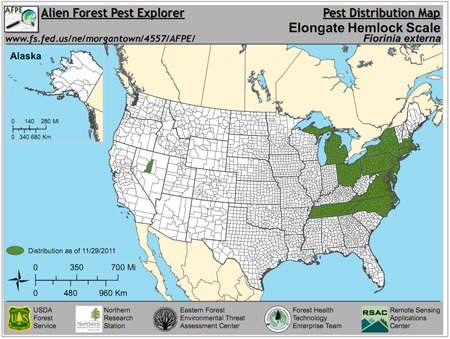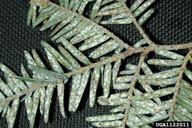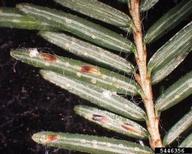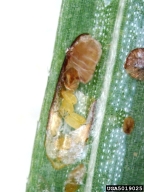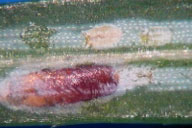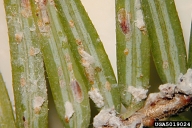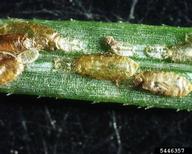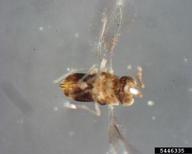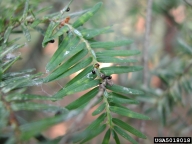Elongate hemlock scale
Fiorinia externa Ferris (Hemiptera: Diaspididae)
Orientation to pest
Elongate hemlock scale, Fiorinia externa Ferris, an invasive scale in the USA, is native to Japan and China that is a pest of eastern hemlock (Tsuga canadensis [L.] Carrière) in the eastern United States. The scale has long-lived adult females that reproduce slowly over much of the year, leading to a population with highly overlapping life stages. In New England there is one generation per year but there are two in North Carolina. Damage can be serious in eastern USA on hemlock, with densities 1-3 thousand-fold higher than in Japan, causing chlorosis, needle drop, and tree mortality.
Hosts commonly attacked
This scale attacks principally eastern hemlock (T. canadensis), but sometimes species of spruce or fir (Abies), Douglas-fir (Pseudotsuga menziesii [Mirbel] Franco), or yew (Taxus) are infested.
Distribution
Elongate hemlock scale is native to Japan and China but is invasive in North America from New Hampshire to Georgia and west to Michigan, within range of eastern hemlock. This scale is also invasive in Europe (UK, France).
| Figure 1. Map of North American distribution of elongate hemlock scale, Fiorinia externa |
Images of elongate hemlock scale
| Figure 2. Heavy infestation of elongate hemlock scale on eastern hemlock, showing many white males and some brown adult females | Figure 3. Adult female elongate hemlock scales (brown) | Figure 4. Eggs (yellow) of elongate hemlock scale inside opened scale cover of adult female | Figure 5. Settled first instar nymphs ("crawlers", see right colored, upper right quarter of photo) of elongate hemlock scale |
| Figure 6. Second instar nymph (mid sized, yellow stages) of elongate hemlock scale; also showing brown adult females and white males | Figure 7. Adult female elongate hemlock scales (left) with parasitoid emergence holes; adult Encarsia citrina (right), an often abundant but generally ineffective polyphagous parasitoid found attacking elongate hemlock scale in both North America and Japan | Figure 8. Cybolephalus nr. nipponicus Endrody-Younga, an introduced predatory beetle that sometimes preys on elongate hemlock scale | |
Important biological control agents related to this pest species
Studies by Kristopher Abell (PhD dissertation, Entomology, University of Massachusetts, 2010) have shown that Encarsia citrina (Crawford), a polyphagous aphelinid parasitoid commonly found attacking elongate hemlock scale in both eastern North America and Japan, is only one of many Encarsia, Aphytis and other parasitoid species that attack the scale in Japan, which except for E. citrina are not present in North America. In addition, this same research has confirmed that E. citrina and the susceptible life stage of the scale are asynchronous throughout North America, even where two complete generations of the scale occur as Japan. The lack of synchrony was attributed to overlapping generations and delayed senescence of the adult female scale. Importations of species of parasitoids from Japan has potential to reduce densities of elongate hemlock scale in North America.
Web links for information on elongate hemlock scale
- Fact Sheet | Pennsylvania State University Extension
- Pest Alert | USDA Forest Service, Northeastern Area
- Home & Garden Fact Sheet | Maryland Cooperative Extension Service
- Scientific Notes on Potential Predator Survey | USDA Forest Service, FHP
Discusses results of predator survey in North Carolina and Tennessee, USA
Articles
- McClure, M. S. and M. B. Fe. 1977. Fiorinia externa and Tsugaspidiotus tsugae (Homoptera: Diaspididae): distribution, abundance, and new hosts of two destructive scale insects of eastern hemlock in Connecticut. Environmental Entomology 6: 807-811.
- Preisser, E. L., J.S. Elkinton, and K. Abell. 2008. Evolution of increased cold tolerance during range expansion of the elongate hemlock scale Fiorinia externa Ferris (Hemiptera: Diaspididae). Ecological Entomology 33: 709-715.
- Abell, K. 2010. Population dynamics and biological control of elongate hemlock scale, Fiorinia externa. PhD dissertation, Entomology, University of Massachusetts, Amherst, Massachusetts.
